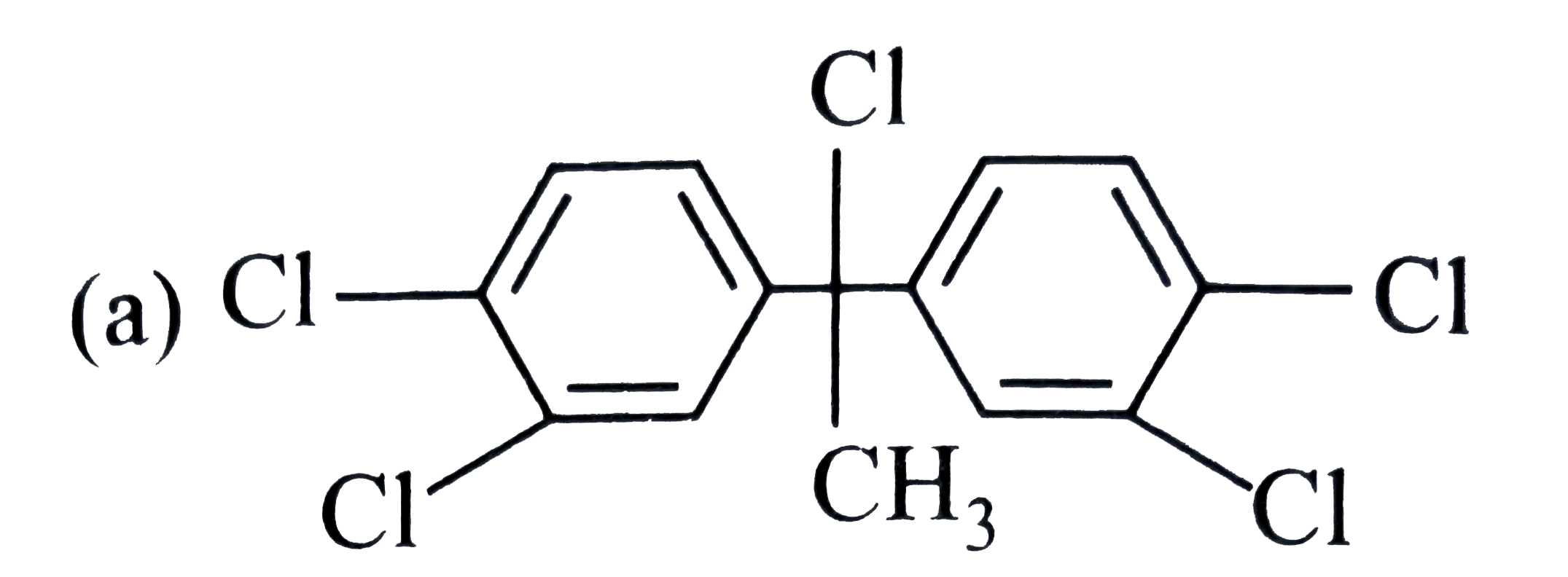How is DDT prepared?
Step-by-Step Solution for the Preparation of DDT
Step 1: Understanding the Structure of DDT
- DDT stands for Dichloro-Diphenyl-Trichloroethane. Its chemical structure consists of two phenyl rings (C6H5) and a trichloroethane group (CCl3-CH).
Hint: Remember that DDT is a compound with two phenyl groups and a trichloroethane moiety.
---
Step 2: Starting Materials
- The preparation of DDT involves chlorobenzene (C6H5Cl) and trichloroacetaldehyde (CCl3CHO) as the primary reactants.
Hint: Identify the starting materials that will react to form DDT.
---
Step 3: Reaction Conditions
- The reaction is carried out in the presence of sulfuric acid (H2SO4) in an acetic medium. This acidic environment is crucial for the reaction to proceed.
Hint: Note the importance of the acidic medium for facilitating the reaction.
---
Step 4: Formation of the Electrophile
- In the reaction, the trichloroacetaldehyde (CCl3CHO) undergoes a reaction where the carbonyl carbon (C=O) becomes positively charged, forming a carbocation. The oxygen of the carbonyl group gains a proton (H+) from the acid, leading to the formation of a positively charged intermediate.
Hint: Focus on how the carbonyl group transforms into a carbocation, which is essential for electrophilic substitution.
---
Step 5: Electrophilic Substitution with Chlorobenzene
- The carbocation acts as an electrophile and undergoes electrophilic substitution with chlorobenzene. The preferred position for substitution is the para position due to steric and electronic factors.
Hint: Remember that electrophilic substitution reactions favor the para position in aromatic compounds.
---
Step 6: Formation of the Intermediate Product
- The product formed after the first substitution is a compound with a hydroxyl group (OH) and a trichloro group (CCl3) attached to the benzene ring.
Hint: Keep track of the functional groups introduced during the substitution process.
---
Step 7: Dehydration to Form Carbocation
- The hydroxyl group (OH) can lose a proton (H+) to form a positively charged carbocation again. This step is crucial as it prepares the compound for another round of electrophilic substitution.
Hint: Understand the role of dehydration in regenerating the carbocation.
---
Step 8: Second Electrophilic Substitution
- The newly formed carbocation undergoes a second electrophilic substitution with another molecule of chlorobenzene at the para position.
Hint: This step reinforces the concept of multiple substitutions leading to the final product.
---
Step 9: Final Product Formation
- The final product of the reaction is DDT, which is formed after two electrophilic substitutions on chlorobenzene, resulting in dichloro-diphenyl-trichloroethane.
Hint: Recognize that the final product retains the structural features of both the phenyl groups and the trichloroethane moiety.
---
Summary
The preparation of DDT involves the reaction of chlorobenzene with trichloroacetaldehyde in an acidic medium, leading to two electrophilic substitutions that yield the final product, dichloro-diphenyl-trichloroethane.
- DDT stands for Dichloro-Diphenyl-Trichloroethane. Its chemical structure consists of two phenyl rings (C6H5) and a trichloroethane group (CCl3-CH).
Hint: Remember that DDT is a compound with two phenyl groups and a trichloroethane moiety.
- The preparation of DDT involves chlorobenzene (C6H5Cl) and trichloroacetaldehyde (CCl3CHO) as the primary reactants.
- The reaction is carried out in the presence of sulfuric acid (H2SO4) in an acetic medium. This acidic environment is crucial for the reaction to proceed.
- In the reaction, the trichloroacetaldehyde (CCl3CHO) undergoes a reaction where the carbonyl carbon (C=O) becomes positively charged, forming a carbocation. The oxygen of the carbonyl group gains a proton (H+) from the acid, leading to the formation of a positively charged intermediate.
- The carbocation acts as an electrophile and undergoes electrophilic substitution with chlorobenzene. The preferred position for substitution is the para position due to steric and electronic factors.
- The product formed after the first substitution is a compound with a hydroxyl group (OH) and a trichloro group (CCl3) attached to the benzene ring.
- The hydroxyl group (OH) can lose a proton (H+) to form a positively charged carbocation again. This step is crucial as it prepares the compound for another round of electrophilic substitution.
- The newly formed carbocation undergoes a second electrophilic substitution with another molecule of chlorobenzene at the para position.
- The final product of the reaction is DDT, which is formed after two electrophilic substitutions on chlorobenzene, resulting in dichloro-diphenyl-trichloroethane.
The preparation of DDT involves the reaction of chlorobenzene with trichloroacetaldehyde in an acidic medium, leading to two electrophilic substitutions that yield the final product, dichloro-diphenyl-trichloroethane.
Topper's Solved these Questions
- BOOK - PRADEEPCHAPTER - HALOALKANES AND HALOARENESEXERCISE - ADDITIONAL QUESTIONS (SHORT ANSWER QUESTIONS)47videos
HALOALKANES AND HALOARENES
- BOOK - PRADEEPCHAPTER - HALOALKANES AND HALOARENESEXERCISE - ADDITIONAL QUESTIONS (LONG ANSWER QUESTIONS)4videos
HALOALKANES AND HALOARENES
- BOOK - PRADEEPCHAPTER - HALOALKANES AND HALOARENESEXERCISE - NCERT EXEMPLAR PROBLEMS WITH ANSWERS, HINTS AND SOLUTIONS (LONG ANSWER QUESTIONS)3videos
HALOALKANES AND HALOARENES
- BOOK - PRADEEPCHAPTER - GENERAL PRINCIPLES AND PROCESSES OF ISOLATION OF ELEMENTS EXERCISE - Curiosity Questions2videos
GENERAL PRINCIPLES AND PROCESSES OF ISOLATION OF ELEMENTS
- BOOK - PRADEEPCHAPTER - ORGANIC COMPOUNDS CONTAINING NITROGENEXERCISE - IMPORTANT QUESTIONS FOR BOARD EXAMINATION27videos
ORGANIC COMPOUNDS CONTAINING NITROGEN
Similar Questions
Knowledge Check
- Question 1 - Select One
The increasing DDT is prepared by heating chorobenzene with chloral (CCI3CHO) in the presence of once sulphuric acid Which of the following compounds is DDT ?
A B
B C
C D
D
What is a 'soap' ? How is it prepared ?
View SolutionWhat is Grignard reagent? How is it prepared? Why are they prepared under anhydrous condition?
View SolutionHow is Idli prepared?
View SolutionHow aniline yellow is prepared?
View SolutionHow is Buna-S prepared ?
View SolutionHow an Accounting Voucher is prepared?
View SolutionHow will you prepare deuteroisopropane ?
View Solution
